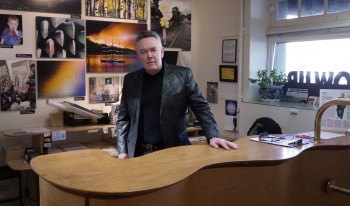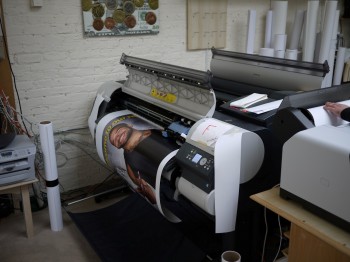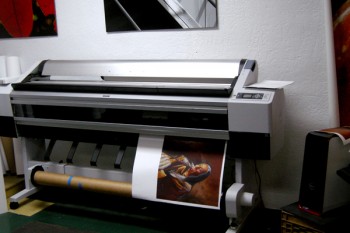 Leighton and Katrina Kirkpatrick, owners of Red River Photo Services in Oklahoma City, have created a business that emphasizes the experience. What Red River Photo means by that is how the customer is drawn in and made a part of the entire printing experience from the beginning.
Leighton and Katrina Kirkpatrick, owners of Red River Photo Services in Oklahoma City, have created a business that emphasizes the experience. What Red River Photo means by that is how the customer is drawn in and made a part of the entire printing experience from the beginning.
“This is an open place; there’s no front counter where customers have to talk to someone in the front about what they need, where it then gets passed to someone in the back who passes it to someone else in the back who tries to interpret what three other people said about the project,” explains Leighton Kirkpatrick. “That’s been a big part of our success and one of the reasons we grew last year… Personal involvement and letting them be part of the experience. We bring them right into the shop right where we’re working and sit down at the computer with them to go through their project. We combine a place that’s enjoyable to visit – where they will be treated in a friendly and helpful fashion – with a final product that exceeds their expectations.”
This is not idle “customer service” talk. It’s based on more than 35 years of experience in imaging, first in film and now in digital output. Red River Photo Services has been based in Oklahoma City for more than eight years. Previously, Leighton had a successful lab in New York City for more than 18 years, catering to modeling agencies, advertising firms and other high-end clientele.
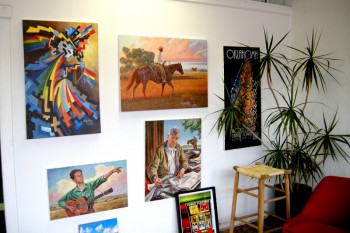
Katrina is originally from Oklahoma City, so the pair decided to settle down there, bringing some of the New York-based business with them. “We were doing work for agencies all over, so for many of them it didn’t really matter where we were located,” says Leighton. “I’m glad we had that business because it took us a couple of years to get established locally.”
And get established they did. Shortly after making the move, Red River Photo began making the transition from a chemical lab to fully digital. As Leighton explains, it wasn’t an easy transition, particularly for someone who had been so immersed in all the ins, outs, nuances and details of the chemical process.
“I love it now. It’s irreplaceable and we’ve become very skilled at it. I wouldn’t go back in the darkroom,” says Leighton. “I’ve been doing this for 35 years. Katrina’s been doing it for five to six years and her enthusiasm helps keep me enthusiastic. She’s very good at what she does and she’s as good at printing as I am, which takes a lot of heat off of me. Plus, she is very good with our customers.”
Not only did Red River shift from film to digital, the business itself and the market it serves has evolved, particularly over the past few years. While the company’s specialty is still true-color fine art and photographic reproduction, its growth has been mainly on the commercial side. Red River works with design and architecture firms and corporations to help them full realize the potential of their branding and image.
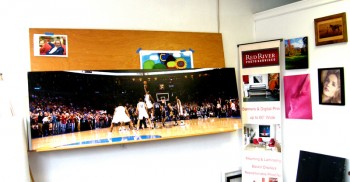
“We do just about everything here, and you have to do that as a small business in a relatively small city. We had our best year last year, and it’s been mainly word of mouth and attention to quality that has helped build this business,” says Leighton. “We’re the only art and photo company other than the larger graphics houses that have a 64-inch printer, which has also enabled us to gain more business. We wouldn’t be able to print what we’re doing for the Thunder [Oklahoma City’s NBA franchise] if we didn’t have that machine.”
Red River Photo has an Epson 11800, an Epson 9800 and two Epson 9600s. While the added horsepower and width certainly helps, an important differentiator has been Red River Photo’s willingness to experiment, and experiment successfully, with a lot of different inkjet media.
“I need to know about new products, and my reps at LexJet tell me what’s coming out and what’s being changed or discontinued across the industry, so I’m always in the know. It also helps with sales because it enables me to go to my clients and let them know about those new products and what they can do for them,” says Leighton. “Product delivery from LexJet has been perfect as well. They tell me when it’s going to get here, and it gets here, and if it doesn’t, they fix it.”
Leighton says his favorite products, which are also customer favorites, include Water-Resistant Satin Cloth for both backlit and frontlit applications, Polyvoile for large, lightweight banners, Sunset Photo eSatin for all kinds of applications, Premium Archival Matte for non-reflecting poster work and Sunset Select Matte Canvas.

“We’ve been applying graphics to a lot of different substrates. We recently produced about 55 prints mounted on Aluma-Panel for Chesapeake Energy. We used eSatin and applied a luster laminate over the prints. I love the eSatin. We use it more than anything else, because it has very good color saturation and when you put it in the machine you know what you’re going to get,” says Leighton.
Leighton expects to continue growing in this direction in the future, blending Red River Photo’s color and image expertise with commercial displays, or what he calls “fine art displays” for commercial clients.

